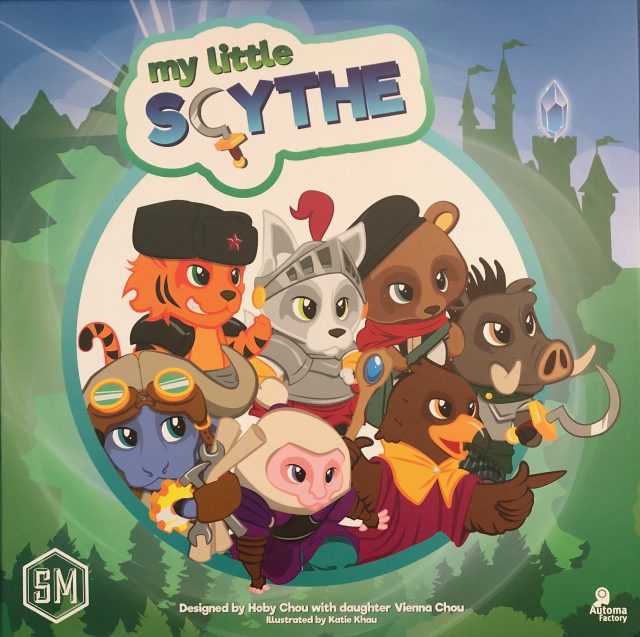Does the name Tim Owens ring a bell? Anyone?
In 1996 Owens went from being an unknown with a Judas Priest cover band to joining his idols as lead singer when original frontman Rob Halford left. The 2001 movie Rock Star (with Mark Wahlberg and Jennifer Anniston) is a (very) loose adaptation of his story–though both he and the band disavowed it after its release.
Realistic or not, Rock Star embodied the hope of every wannabe: that one day their hard work and ability would be recognized and they would be plucked from obscurity to enjoy the success their devotion surely deserves.
Owens’ story is what comes to mind when I think about Hoby Chou, a gamer who appears to be from British Columbia from what I can find online, and who definitely is a father who wanted to bring his daughter into the big tent of tabletop gaming.
 In 2016 Chou (like many of us) fell in love with Scythe, one of the best games to be released in the last few years. With its sandbox many-paths-to-victory design, with intricate and interlocking design elements, its asymmetric factions, and above all its immersive graphic design, Scythe has to be the epitome of the best in current game design.
In 2016 Chou (like many of us) fell in love with Scythe, one of the best games to be released in the last few years. With its sandbox many-paths-to-victory design, with intricate and interlocking design elements, its asymmetric factions, and above all its immersive graphic design, Scythe has to be the epitome of the best in current game design.
But Chou’s seven-year-old daughter wanted to play, too.
So he started thinking about whether he could adapt Scythe for a seven-year-old. Reskinning the game was easy enough but surely insufficient–the game is hard enough for grownups to play. No, this required prying open the chassis and tinkering with the innards.
What a daunting task! Changing or removing one element and risked throwing everything else off-balance. And yet Chou–with considerable help from his daughter–persisted and thus was born My Little Scythe. Set in the world of My Little Pony, the game worked, and Chou proceeded to do what many BGG users do in the same situation: he uploaded the new rules and files to BGG, hoping that others would enjoy what he and his daughter had created.
It turned out lots of people loved Scythe but had trouble sharing it with loved ones because of its theme and difficulty. My Little Scythe turned out to meet this need on a level that Chou could never have dreamed of. It became a print-and-play sensation and won the 2017 Golden Geek Award. That alone would have been satisfying enough from a designer point of view, but the story didn’t end there.
The Internet being what it is, it was almost inevitable that Jamey Stegmaier, Scythe’s designer and publisher, came to hear about My Little Scythe. He could have huffed and harumphed and slapped Chou with a cease-and-desist order. Such things had happened before; publishers have stomped on fan-made adaptations even though no money has changed hands because they fear the poisoning of the brand, or fear that attention (and sales) will suffer.
Instead, Stegmaier appreciated the effort and care that had gone into adapting his work. And, with his business hat on, he perceived that My Little Scythe had indeed found an untapped market which he could monetize.
And so it was that Stonemaier Games bought Chou’s design, tweaked it gently in a few places, and have released it as an official design. Along the way it shed the “My Little Pony” IP for copyright reasons but managed to retain the name as well as the whimsical charm of that world.
Players now represent teams of animal Seekers roaming the Kingdom of Pomme vying for royal trophies by delivering the game’s resources (gems and apples) to Castle Everfree, winning pie fights, completing quests, levelling up abilities, and so on. The first player to win four trophies wins.
Fans of Scythe will find plenty of other familiarities. Although much has been stripped out or down (upgrades; Factory powers; only two resources and three Actions), the flavour of the original survives. Actions fall into three categories: Move, Seek (spawn new resources on the map), and Make (turn gems and apples into other things). Players take a single action on their turn, but they can’t take the same action twice in a row (although the new action might belong to the same category as the previous one). There is a touch of asymmetric play in the Personality cards that players get at the game’s start that make one of the objectives a little easier for them to fulfill.
There is a little more luck here, as you would expect from a game for kids. Seeking is dice-driven, and upgrades are randomly chosen. But even in those cases there are choices and opportunities for strategic play.
Best of all, the game even contains Automa rules like its mama, so that you can play solo against any number of bots (the rules suggest playing on a team with your child against a bot as a great cooperative experience). There are also rules for faction team play, which would be interesting to graft back onto the original game.
As you would expect from Stonemaier, the production design is lavish and high-quality, with amazing chibi-like minis for the Seekers (there are painting guides for them included), huge gem-like gems, and a great pair of inserts which organize everything in the box.
My Little Scythe could go on to become a landmark gateway game, sitting in that sweet spot where family-friendly theme and components meet strategy game. Hoby Chou and his daughter deserve to enjoy their success, and you deserve to enjoy the fruits of their labour.
Comments
No comments yet! Be the first!